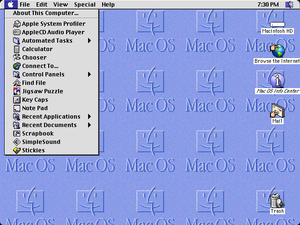Mac OS 8.1
| A version of the Classic Mac OS operating system | |

Screenshot of Mac OS 8.1
|
|
| Developer | Apple Computer |
|---|---|
| OS family | Macintosh |
| Working state | Historic, unsupported |
| Source model | Closed source |
| Released to manufacturing |
July 26, 1997 |
| Latest release | 8.6 / May 10, 1999 |
| Kernel type |
Monolithic (68k), nanokernel (PowerPC) |
| Default user interface | Apple Platinum |
| License | Proprietary |
| Preceded by | System 7 |
| Succeeded by | Mac OS 9 |
| Official website | N/A |
| Support status | |
| Unsupported as of May 2001 | |
Mac OS 8 is an operating system (OS) that was released by Apple Computer on July 26, 1997. It represented the largest overhaul of the classic Mac OS since the release of System 7, some six years before. It put more emphasis on color than prior operating systems. Released over a series of updates, Mac OS 8 was an effort to integrate many of the technologies developed for Apple's overly-ambitious OS named Copland. Mac OS 8 helped modernize the Mac OS while Apple developed its next generation operating system, Mac OS X. Mac OS 8 is one of Apple's most successful software releases, selling over 1.2 million copies in the first two weeks. Coming as it did at a difficult time in Apple's history, many pirate groups refused to traffic in the new OS, encouraging people to buy it instead.
Mac OS 8.0 brought about the most visible changes in the line-up, including the introduction of the Platinum interface and a native PowerPC multithreaded Finder. Mac OS 8.1 introduced a new, more efficient file system named HFS Plus. Mac OS 8.5 was the first version of the Mac OS to require a PowerPC processor. It featured PowerPC native versions of QuickDraw, AppleScript, and the Sherlock search utility. Its successor, Mac OS 9, was released on October 23, 1999.
Apple's next generation operating system, which it originally envisioned as "System 8" was codenamed Copland. It was announced in March 1994 alongside the introduction of the first PowerPC Macs. Apple intended Copland as a fully native PowerPC system offering intelligent agents, a microkernel, a customizable interface named Appearance Manager, a hardware abstraction layer, and a relational database integrated into the Finder. Copland was to be followed by Gershwin, which promised memory protection spaces and full preemptive multitasking. The system was intended to be a full rewrite of the Mac OS, and Apple hoped to beat Microsoft Windows 95 to market with a development cycle of only one year.
...
Wikipedia
